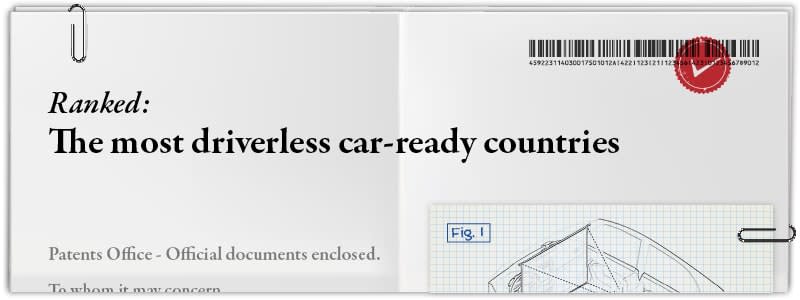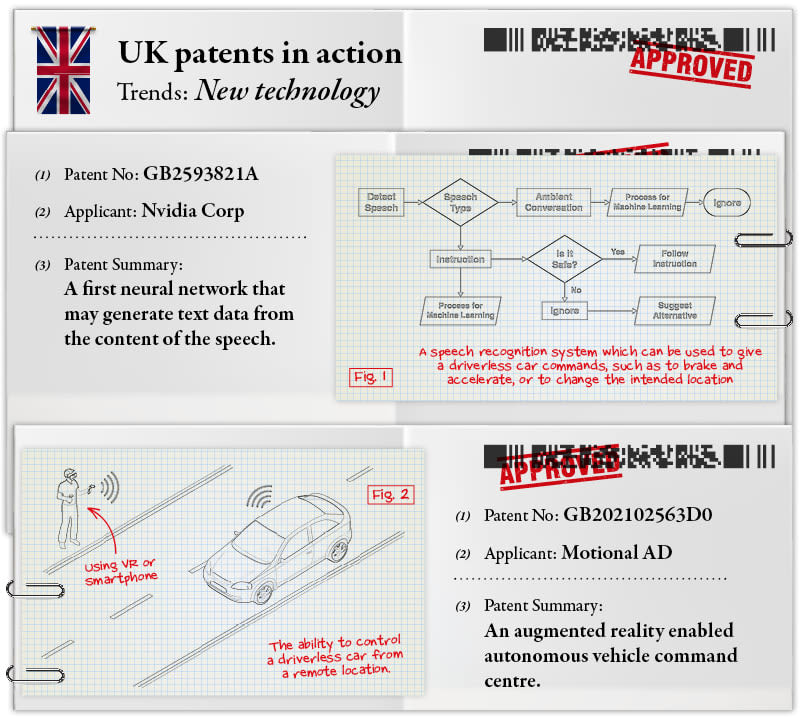
Driverless cars have been a topic of discussion in the automotive industry for a number of decades at this point, but are we actually any closer to seeing the reality of vehicles on the road without a human being behind the wheel?
We have analysed patents from around the world related to the development of driverless cars, determining which country may be leading the way in the race to be ready for autonomous motoring.
We took a deeper dive into the patents submitted to reveal the whackiest ideas that each country has in mind for an autonomous future.
USA has filed the most driverless car patents
When looking at total patents, the United States of America’s patent office, the USPTO has seen the most applications for driverless car-related technology, with a huge 135,828.
These patents are extremely wide ranging, and some go as far back as the 1950s. 2017 seemed to be a big year for new driverless car patents across a range of countries, as the USA submitted 49% more patents than in 2016, with China (28%), Japan (34%), South Korea (68%), and Germany (56%) all massively increasing their new filings too.
A reason why this may be the case is that Waymo, Google’s old self-driving project, announced that they would start testing self-driving cars in 2017. This could have then inspired tech businesses in other countries to follow suit.
Patent applications have become extremely high tech in recent years, with a 2015 patent by Dov Moran and Menahem Lasser dedicated to altering predicted accidents between driverless cars.
The solution they proposed was to have each driverless car wirelessly transmit information about itself via non-visual electromagnetic radiation, so that other driverless cars around them could use that information to inform their own decisions and avoid collisions.
Though the USA leads the way for driverless car patents in the all-time list, China was not far behind on a total of 132,844 results. These patents ranged from steering control methods to traffic sign recognition.
Other countries to have a high number of patents related to driverless cars were Japan (57,065), South Korea (38,097), and Germany (33,512).
| Country | Driverless car-related patents of all time |
| 1. United States of America | 135, 828 |
| 2. China | 132, 844 |
| 3. Japan | 57, 065 |
| 4. South Korea | 38, 097 |
| 5. Germany | 33, 512 |
| 6. Canada | 14, 585 |
| 7. Australia | 14, 026 |
| 8. Russian Federation | 12, 121 |
| 9. France | 9, 488 |
| 10. Spain | 7, 145 |
China leads the way for patents filed in the last year
Though historically the USA is ahead in the driverless car race, China’s patent office has seen the most since the start of 2021 with nearly 4,000 more than their American counterparts.
| Country | Driverless car-related patents since 2021 |
| 1. China | 11, 096 |
| 2. United States of America | 7, 205 |
| 3. Germany | 719 |
| 4. South Korea | 717 |
| 5. Japan | 633 |
| 6. Australia | 361 |
| 7. Russian Federation | 166 |
| 8. Israel | 139 |
| 9. Canada | 76 |
| 10. United Kingdom | 60 |
Chinese manufacturers aren’t alone in ramping up research into autonomous vehicles, however, with South Korea (717) and Japan (633) also in the top five for driverless car patents filed in the last year.
The UK is surprisingly low on the list, only coming in 10th with 60 patents filed since the beginning of 2021. It would appear that if anyone is going to make a full breakthrough in the race for fully autonomous motoring, it’s highly likely to be either the USA or China.
Chinese patents look to the skies with flying car ideas
A common theme of Chinese patents filed in the last year is looking into the possibility of flying cars, with one particular patent looking at take-off and landing technology - getting it into the air is the best place to start…
.jpg)
China is also looking past flying cars and even approaching flying unmanned robots, which could be used to assist an autonomous car in various ways, such as traffic surveillance. The unmanned robot could fly ahead of the car’s designated route and highlight any potential issues such as heavy traffic or obstacles up ahead, and the car can react accordingly.
US patents focus on comfort and entertainment
In the US, inventors have put a lot of their focus on the comfort and entertainment of the passengers in their driverless cars. One such patent looked at an on-board entertainment system so you can enjoy the cinema experience while your car drives itself. All mirrors would have a mini screen on them, so even when checking your rear view, you won’t miss out on your movie.
.jpg)
Another US patent, this time from Uber Technologies, looks at the seating of autonomous cars, in particular the ability to change how many seats the vehicle has, depending on the number of passengers. These seats are also designed specifically for relaxation and comfort with unneeded seats folding away to create more room for onboard passengers and vice versa.
Another innovation submitted in the US is an autonomous charging robot, the perfect solution to any range anxiety drivers have while on the road. The robot can navigate roads without any human input, drive alongside your car and charge it while still on the road. Once fully charged, the self-driving charger detaches and heads off to its next car.
German inventors prioritise passenger health, safety and security
Over in Germany, many of their recent patents have been looking at maximising the safety of all passengers on board autonomous vehicles. A patent from Motional AD outlines a plan to monitor and examine the health of passengers, which can sense and diagnose a variety of health conditions.
.jpg)
For example, if the passenger was at risk of a heart attack or stroke, the internal sensors would highlight this and alter its destination to the nearest hospital, or emergency services location.
This genius invention would monitor heart rate, breathing pattern and other vital signs to ensure the passenger is fit and well while in the car.
Another patent, this time from Ford Global Technologies, looks at managing user profiles and preferences in autonomous vehicles. This could be used in a variety of ways, including outlining possible extra needs for disabled passengers as well as the autonomous vehicle having the ability to receive a request from a passenger for a start and end location of a trip or to pick up another passenger that may be in need of assistance.
Staying on the security theme, a German patent from Mercedes Benz describes a method for the detection of unauthorised or illegal goods. The automated vehicle would use sensors to scan for unwanted goods such as drugs that may be placed in the vehicle by a third party that is aware of the vehicle’s destination, such as if it was travelling over a border from one country to another.
Thus, this invention would alert the authorities that the vehicle was carrying illegal goods, and are dealt with accordingly to prevent unwanted crime from taking place on the autonomous vehicle.
South Korean manufacturers are all about the interiors
The South Korean patents tend to have a common theme, a focus on improving the interiors of autonomous cars. One of which is the invention of an optical device that can change the windows automatically and protect the glass in the windows of the car against environmental elements that could otherwise damage the car, including beaming sunlight and harsh weather conditions.
.jpg)
For those that are looking to spend a lot of time in their car, another patent looks at the creation of a heater without ignition for an autonomous vehicle. Keeping the car or van warm without needing to switch the engine on would be crucial that those that often take long road or camping trips. This heater would work via a fuel tank, located at the rear of the vehicle, supplying the energy needed to heat the interior of the car or van.
Also, in the interior of the car, a separate Korean patent looks at a system for controlling the interior of a vehicle via a user-responsive hologram. Using holograms in everyday technology is a bold move, and in this invention, it would take the place of the most commonly found car dashboard: the touch screen.
The control device would work via a passenger moving their eyes or hands towards the controls to kickstart the gesture recognition system.
Once this is activated, hand gestures can be used to navigate through the dashboard and controlling the vehicle in this way, including setting the car on a certain path, changing media that may be displayed on the car’s screens, or calling people on the phone, as a few examples.
The UK still in an early testing stage, but there are still interesting themes
When compared with other countries on the list, the UK lags behind a little in the race for driverless cars, though there are still eye-catching patents being filed in the British Isles. One such patent is related to speech recognition, allowing processors to understand different commands and accents. If used in an autonomous car, this could allow for verbal commands such as changing the end location of the journey or even brake or accelerate on command.

Another intriguing patent from Motional Ad is focused on the development of an augmented reality-enabled autonomous vehicle command centre – with the potential for a human to control a car from a separate location using a mobile device. Could this be a sign of things to come in the next few years?
Methodology
Select used Google Patents to determine which countries are winning the race for fully autonomous motoring, through analysing the results related to ‘driverless cars’ by each patent office.
This was done both for all time, and for the period from 1st January 2021 to the present day. The latter information was used to determine the technology that we could see introduced to driverless vehicles in the coming years, with details seen in our annotated images.
Enjoyed this? Read more articles similar to this one:
- Elon Musk’s earnings in real time
- The future of cars according to kids
- The driving related dangers of the dark web
- The worlds most traffic jammed countries
- Calculate your risk of developing driving-related health issues
Where To Next?
For all the latest reviews, advice and new car deals, sign up to our newsletter.
Looking for a great leasing deal? Check out our incredible range of special offers.
Read our latest reviews and find the right model for you.
Want to know more about leasing? Take a look at our comprehensive leasing guides.
Interested in everything motoring? Why not catch up on all the latest car leasing news.














